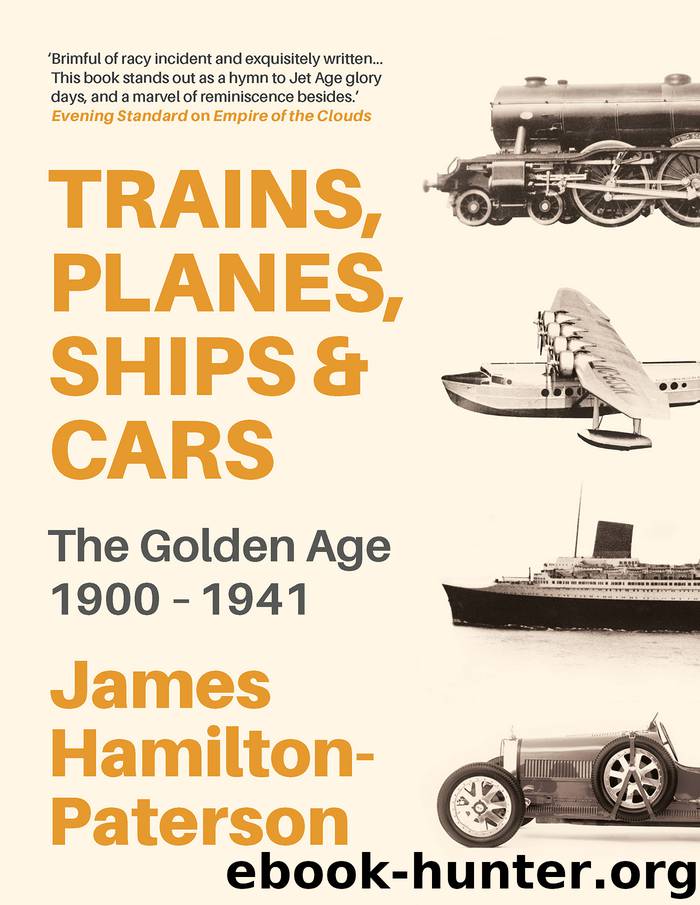Trains, Planes, Ships and Cars by James Hamilton-Paterson

Author:James Hamilton-Paterson [Hamilton-Paterson, James]
Language: eng
Format: epub
ISBN: 9781789542356
Publisher: Head of Zeus
The skeletal remains in northern France of Britain’s R101 in October 1930. Known as the ‘socialist’ ship for having been built at state expense, it was overburdened with complex technology. Its fiery end cast a pall over the future of airship travel.
© Mary Evans
In such remarks about the undemocratic and uncommercial nature of airship travel there was an uncanny foretaste of the criticisms that fifty years later would be aimed at Concorde. The world’s first supersonic airliner brought glory to France and Britain much as the Graf Zeppelin had to Germany, and similar avowals were made about the unstoppable pace of the technological progress it represented. Even apart from the prodigious costs of its development and construction, ultimately funded by the taxpayers of France and Britain, Concorde could never conceivably have made any airline a profit. The aircraft’s usual payload of executives, rock stars and their baggage formed a mere 6 per cent of its all-up weight, the largest proportion of the rest being fuel. Both the Graf and Concorde showed it is a simplistic error always to equate progress with anything that makes life more convenient or flashier for businesspeople and celebrities. Another popular mistake made about airships and Concorde alike was to assume – as many people still do – that air travel must inevitably involve ever-greater speed and luxury, whereas its economics actually show that progress in civil aviation is better measured by aircraft that will carry more passengers more cheaply (as Boeing’s 747 quickly established). A new generation of smaller supersonic executive jets will soon once again challenge the exceptionalism conferred on the super-wealthy, whose upper-atmospheric carbon footprint will be proportionally larger than anybody else’s apart from the military.
The fire that consumed R101 turned out to be a major nail in the coffin of airships’ reputation. Anyone connected with Zeppelins had always carried at the back of their minds a constant awareness of how very dangerous hydrogen was as a lifting gas. The safe alternative was helium because it is inert, but it was unavailable in bulk in Europe. Helium in quantity had first been discovered beneath the United States’ Great Plains as a component of natural gas before the First World War. For many years this gave America a virtual monopoly of the element. In 1925 the US Helium Act banned its export because the extent of this natural resource was still not known. As a consequence, Zeppelins and other airships like the R100 and R101 were condemned to use highly flammable hydrogen as their lifting gas while US naval airships were borne safely aloft by helium.
The Graf continued its flights and was received with celebrations everywhere. However, its last appearance in Chicago in October 1933 was noticeably cooler because now, to conform with a new Nazi law, the airship carried a vast swastika emblazoned on the tail. Dr Eckener, who despised Hitler and the new German government, was humiliated by this requirement but had to obey. Still, he was cheered by the knowledge that
Download
This site does not store any files on its server. We only index and link to content provided by other sites. Please contact the content providers to delete copyright contents if any and email us, we'll remove relevant links or contents immediately.
| Automotive | Aviation |
| History | Mass Transit |
| Owner's Manuals & Maintenance Guides | Railroads |
| Reference | Ships |
Small Unmanned Fixed-wing Aircraft Design by Andrew J. Keane Andras Sobester James P. Scanlan & András Sóbester & James P. Scanlan(32743)
Navigation and Map Reading by K Andrew(5111)
Endurance: Shackleton's Incredible Voyage by Alfred Lansing(4676)
And the Band Played On by Randy Shilts(2127)
Wild Ride by Adam Lashinsky(1933)
The Box by Marc Levinson(1930)
Top 10 Prague (EYEWITNESS TOP 10 TRAVEL GUIDES) by DK(1929)
The Race for Hitler's X-Planes: Britain's 1945 Mission to Capture Secret Luftwaffe Technology by John Christopher(1817)
The One Percenter Encyclopedia by Bill Hayes(1787)
Trans-Siberian Railway by Lonely Planet(1701)
Girls Auto Clinic Glove Box Guide by Patrice Banks(1683)
Bligh by Rob Mundle(1653)
Looking for a Ship by John McPhee(1629)
Batavia's Graveyard by Mike Dash(1606)
Good with Words by Patrick Barry(1599)
TWA 800 by Jack Cashill(1592)
Fighting Hitler's Jets: The Extraordinary Story of the American Airmen Who Beat the Luftwaffe and Defeated Nazi Germany by Robert F. Dorr(1591)
Troubleshooting and Repair of Diesel Engines by Paul Dempsey(1556)
Ticket to Ride by Tom Chesshyre(1542)
